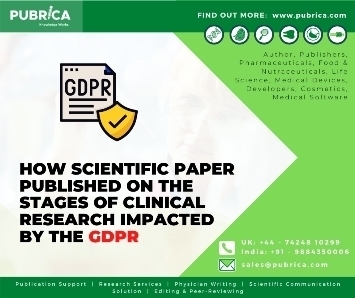
How scientific paper published on the stages of clinical research impacted by the GDPR
September 16, 2020
Major manuscript categories are seen in on Cardiovascular Computed Tomography
September 21, 2020In brief
- Neuropsychiatry has always been a mystery area with researchers, all over the world, trying to understand affective, behavioural characteristics and mental illnesses. Research is often limited by the complex structure and function of the brain, difficulty in imaging techniques and access to direct tissue for pathophysiological studies.
- However, recent times have seen a impressive improvement in the understanding of these neuropsychiatric disorders, most of which can be explained by an interplay between genetic, environmental, and biological factors.
- Video abstract services convert the research in the form of an audio-video format that is engaging, accessible, and increases the chances of getting accepted by the scientific publishing community.
Brain – a complex organ
The human brain is an extremely complex organ and understanding its functioning has always been a mystery and hence a field of research for the curious researcher. Genetics and environment have both known to influence the outcome of the person; however, the extent to which each factor affects the outcome is not completely understood. The nature and nurture influence on the human brain is a mystery and debates continue to understand conclusively the same.
The brain is highly sensitive and receptive to biological and environmental factors especially in the prenatal and early childhood as the neural pathways are being formed and these factors along with genetic makeup decide experiential learning pathways that guide an individual throughout his or her life.
Biological factors and mental illness
Biological factors are internal factors and range from genetic to chemical, physical, physiological, nutritional, hormonal, and neurological, gender etc. It is studied that about half of the mental illnesses would have had their onset by 14 years of age and three quarters by the time one is 24 years, and this then persists through adulthood.Neuropsychiatric illnesses are a major cause of disease burden affecting productive adult life and is the most common cause of disease burden in the young. In spite of this, mental illnesses are neglected and underfunded area of research.
Several mental illnesses are linked to disturbances in the functioning of neural circuits and imbalance in neurotransmitters. By influencing the levels of neurotransmitters through medications, psychiatrists attempt to manage the symptoms of mental illnesses by influencing the neural pathways.
The following are known biological factors that are antecedent to the expression of mental illnesses:-
- Genetics – The fact that mental illnesses show hereditary pattern, prove that there is a strong genetic component for the causation of these illnesses. They are usually involving several genes that increase susceptibility to a mental disease that is triggered by environmental exposures. Serotonin or 5-HT is an important neurotransmitter that affects mood. Genetic polymorphisms in serotonin receptor (SERT), corticotrophin releasing hormone receptor (CRH-R) and brain-derived neurotrophic factor (BDNF) increase vulnerability to childhood depression when exposed to stressors.
- Infections –An example is the paediatric autoimmune neuropsychiatric disorder (PANDAS) caused by Streptococcal infection is linked to development of obsessive-compulsive disorder (OCD) in children.
- Brain injury and prenatal damage – Brain defects and injury are associated with development of mental disease, while prenatal asphyxiation and injury can result in autism.
- Substance abuse – long term substance abuse is associated with anxiety, depression, and paranoia.
- Nutrition – malnutrition results in mental illness.
Schizophrenia and bipolar disorder
Schizophrenia is a debilitating psychotic illness that affects the young making them unable to lead a normal life. Today, we have convincing evidence to suggest that Schizophrenia starts as a neurodevelopmental anomaly in the background of predisposing genetic features. The condition worsens with the neurodegeneration that occurs with age, making it a progressive illness. Similar evidences are available to suggest that bipolar disorder is also a neurodevelopmental disorder triggering a genetic condition and worsened by neurodegeneration that occurs with age. Memory disturbances and prefrontal cortex damage associated with cognitive impairment and brain damage are noted in neurodegeneration as well as schizophrenia / bipolar disorder.
Research in neuropsychiatry
The increasing numbers of papers and articles that are in line for publication in neuropsychiatry is alarming and often journals miss out relevant topics during their process of screening. To enable this, medical video abstract services make a small 2-3 minute video summarising the output of the research. Medical writing services are well-accepted in the scientific community considering the time constraint in publication business. Video creation service is another step in this direction to facilitate the process of acceptance of research paper by the publishing journal. A video abstract for the research keeps the attention of the reader by audio-visual aids. Complex areas involved in neuropsychiatry i.e. the brain anatomy, imaging, electroencephalogram tracings, genetic alterations, etc, can be better visualised by video abstract creation using high-definition animation and imagery. In short, video creation service for research narrate the story of your research in the form of a video abstract or abstract video.
Conclusion
Vast amount of research has enabled our understanding of the various biological factors involved in mood, behaviour, and mental illness manifestation and tremendous amount of research is still going on to identify more such factors and the interplay between them. This understanding will help pharmaceuticals to develop targeted therapy to improve outcome and minimize side effects, thereby improving the productivity and quality of life of the young adults. Video development services convert your research abstract into an engaging abstract video that is accessible and easily shared on websites and social media extending the visibility of the research.
References
- Spenrath, M. A., Clarke, M. E., & Kutcher, S. (2011). The science of brain and biological development: implications for mental health research, practice and policy. Journal of the Canadian Academy of Child and Adolescent Psychiatry = Journal de l’Academiecanadienne de psychiatrie de l’enfant et de l’adolescent, 20(4), 298–304.
- Lifetime prevalence and age-of-onset distributions of DSM-IV disorders in the National Comorbidity Survey Replication. Kessler RC, Berglund P, Demler O, Jin R, Merikangas KR, Walters EE. Arch Gen Psychiatry. 2005 Jun; 62(6):593-602.
- World Health Organization . Investing in mental health. Geneva: World Health Organization; 2003.
- Heim C, Shugart M, Craighead WE, Nemeroff CB. Neurobiological and psychiatric consequences of child abuse and neglect. Development and Psychobiology. 2010;52:671–690.
- MassimilianoBuoli, Marta Serati, Alice Caldiroli, Laura Cremaschi& Alfredo Carlo Altamura: Neurodevelopmental versus neurodegenerative model of schizophrenia and bipolar disorder: comparison with physiological brain development and aging. PsychiatriaDanubina, 2017; Vol. 29, No. 1, pp 24-27
